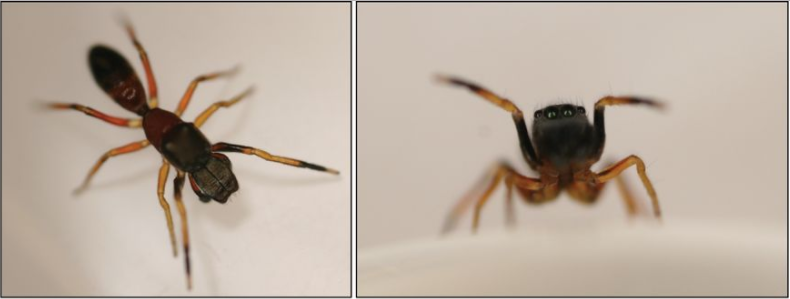This Spider Really Commits to Its Ant Impression
Posted on Categories Discover Magazine

It’s a good thing field sobriety tests don’t exist for bugs, because the jumping spider Myrmarachne formicaria would fail for doing what keeps it alive: walking in a wobbly line. The spider fools predators by imitating an ant. The act is so thorough that it includes how the spider looks, stands and even moves.
Many, many types of jumping spiders have evolved to look like ants. Imitating another animal with better defenses is a tried-and-true strategy for avoiding predators. And ants are a good option because they can be aggressive or venomous. A spider that does a decent ant impression can scare off some of its predators without having to evolve those defenses itself.
One of those ant-aping jumping spiders is Myrmarachne formicaria. (Formicaria is Latin for “ant-ish.”) In general, ants are slender, while spiders are chunky; ants have six legs and spiders have eight. But M. formicaria has a stretched-out body. When it stands still, it holds its two front legs in the air, like an ant’s antennae.
Some researchers have suggested that these jumping spiders walk like ants too, maybe by moving exclusively on six legs. To study this more closely, Paul Shamble and his colleagues at Cornell University collected M. formicaria spiders from around Ithaca, New York, and brought them back to the lab. They also collected ants and some other jumping spiders that aren’t ant mimics.
The researchers used high-speed cameras to record all three types of bugs walking across a clear glass surface, then analyzed their gaits in detail. In another setup, the bugs walked on a piece of white poster board and the researchers mapped the paths they took. The team also used liquid containing ant pheromones to paint a path on paper, and observed ants following the path.
Ant-mimicking spiders didn’t follow the same meandering, irregular paths as other jumping spiders. Instead, they walked like ants following a scent trail. The ants, and the mimic spiders, walked in regular sine-wave patterns. (Ants that are not following a trail wander in big loops.)
“They were so strikingly similar to ants-following-trails, and so unlike ants off trails,” says Shamble, who’s now at Harvard University. This unexpected discovery was one of his “favorite bits of this project,” he says.
Whenever the ant-mimicking spiders stopped walking, they held up their two front legs like ant antennae. But, contrary to what others had thought, they walked using all eight legs.
Some spider species have evolved to walk on only six legs and use their front two like antennae—and spiders that are unfortunate enough to lose two legs can carry on just fine. So it “isn’t completely crazy” to think that ant-mimicking spiders might walk on six legs too, Shamble says. The fact that they don’t is interesting. “It could very well be that this ‘6-while-stationary, 8-while moving’ strategy is simply sufficient to fool predators,” Shamble says.
The “good enough” theory held up when the researchers showed animations of the ants, ant-mimicking spiders, and other spiders to predatory spiders. The animations were based on the high-speed videos of each bug. The scientists watched to see when the predatory spiders pounced at the screen. They found that predators were three times more likely to attack spiders that didn’t mimic ants. (And true ants were even safer from attack than ant-mimicking spiders were.)
Ants tend to stay in continuous motion, unlike jumping spiders. But the authors say that the pauses M. formicaria takes—only about 100 milliseconds—are too quick for the eyes of many of its predators (reptiles, amphibians, other spiders) to notice.
While these jumping spiders are doing their best ant impressions, other insects are mimicking the spiders. Some tephritid flies have dark markings on their wings that look like legs. Viewed from behind, a fly with its wings stretched out looks like a jumping spider facing you with its front legs up. “This sounds strange, but it is really quite convincing,” Shamble says. “Some of them even sort of hop back-and-forth the way jumping spiders do.”
So a fly holds its wings out to imitate a jumping spider holding its legs up, and a jumping spider holds its legs up to imitate an ant with its antennae in the air. Is the fly really imitating the ant? Shamble thinks the truth is more complex. The arms-up pose may be a more general signal between bugs that warns others to stay away. “I would love to know the answers,” he says.
Image: Shamble et al.